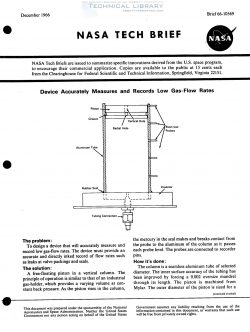NASA-BRIEF-66-10569
- Version
- 78 Downloads
- 119.04 KB File Size
- 1 File Count
- August 19, 2017 Create Date
- August 19, 2017 Last Updated
Device Accurately Measures and Records Low Gas Flow Rates

To design a device that will accurately measure and
record low gas-flow rates. The device must provide an
accurate and directly inked record of flow rates such
as leaks at valve packings and seals.
A free-floating piston in a vertical column. The
principle of operation is similar to that of an industrial
gas-holder, which provides a varying volume at con-
stant back pressure. As the piston rises in the column,
the mercury in the seal makes and breaks contact from
the probe to the aluminum of the column as it passes
each probe level. The probes are connected to recorder
pins.
The column is a seamless aluminum tube of selected
diameter. The inner surface accuracy of the tubing has
been improved by forcing a 0.002 oversize mandrel
through its length. The piston is machined from
Mylar. The outer diameter of the piston is sized for a
sliding fit, so that it will glide down the open column
quite readily, but will sink very slowly if the column
is closed at the bottom. To provide an effective seal,
or ring, for the piston, a ring groove is machined
around the outer circumference. Four holes drilled
radially connect the ring groove to a vertical hole
drilled at the piston centerline.
The piston is inserted in the column and mercury is
poured in the center hole until it rises even with the
top of the piston. The mercury flows through the 4
radial holes, filling the groove with mercury. Since
the mercury cannot “wet” the aluminum of the
column, it will be retainedin the groove under nor-
mal conditions, thus providing an effective seal.
To provide a signal for the recorder a row of insu-
lated electrical probes are cemented in one side of the
cylinder. The points of the probe are exactly flush
with the inner surface of the column and studded on
the outer end for electrical connection. As the piston
rises in the column, the mercury makes and breaks
contact from the probe to the aluminum of the column
as it approaches each probe level. The upper probe
is used as a limit switching‘point for automatic
recycling. The probes are connected to recorder pins.
| File | Action |
|---|---|
| NASA-BRIEF-66-10569 Device Accurately Measures and Records Low Gas Flow Rates.pdf | Download |

Comment On This Post